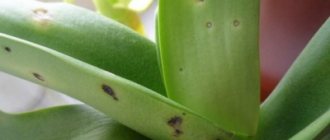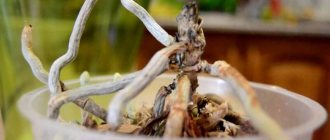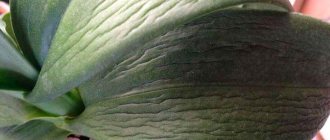Possible causes of blackening of roots
It is not difficult to determine the rotting of the roots: when compressed, water oozes out of them, the top layer is easily separated, revealing the thread-like middle. The occurrence of this condition of the roots can be due to a number of reasons.
Failure to follow plant care rules
For beginning orchid lovers, one of the reasons for root rot is mistakes made in caring for orchids.
Improper watering
- Excess moisture in the pot, or, more simply, overwatering. If there is too much moisture, air access to the roots is cut off. The process of photosynthesis stops, water remains in the velamen and does not enter the leaves. The substrate creates a favorable environment for the development of pathogens. The root system begins to rot.
- Stagnation of water in the leaf axils after sprinkling. If moisture evaporates quickly from the surface of the leaf plate, then it remains in the recesses of the sinuses for a long time. Over time, a putrefactive process develops in this place. In this case, the stem of the plant and along with it the nearby roots begin to rot first. It is almost impossible to save such a plant.
- Therefore, remove any remaining water from the leaf axils. Watering with very cold or chlorinated water will also result in root rot.
It is enough to follow simple watering rules and you can avoid the loss of a wonderful tropical specimen.
Temperature
Low room temperatures and very cold window sills can also lead to slow evaporation of moisture from the substrate. This, in turn, is stagnation of cold water in the roots. In such a situation, the onset of putrefactive processes is also inevitable.
During the cold season, it is necessary to remove orchids from windows. 20 minutes in a draft, and the orchid can lose all its leaves.
Insufficient lighting
Another good reason affecting the appearance of brown spots on the roots.
The force that draws water through the velamen cells higher to the leaves appears only under certain lighting conditions. If the lighting is insufficient, then the water remains in the roots. Over time, it becomes a source of decomposition of the cellular structure of tissues.
With sufficient lighting, the water constantly moves upward, thereby feeding the orchid, which thanks to this grows intensively.
Causes of the disease and pathogens
The main “culprit” of the disease in 90 cases out of 100 is the fungus Pythium ultimum. In addition to it, other fungi are the cause of black rot - Phytophthora omnivora, Pythium debaryanum. Pathogens are especially activated in conditions favorable to it, namely:
- regularly waterlogged soil mixture and, as a result, its compaction, loss of looseness and breathability;
- a decrease in the acidity of the soil mixture, that is, the pH level exceeds 6-6.5, which indicates the neutrality of the substrate or its alkalization;
- an excess of nitrogen in the substrate, resulting from overfeeding the orchid: too frequent fertilizers or overestimating their dose;
- constant high air humidity with irregular ventilation; the thermometer in the room does not fall below 20 degrees at night and less than 30 degrees during the day;
- overheating of the substrate and, accordingly, the root system of plants located indoors, where the temperature for a long time remains in the range from 25 to 33 degrees Celsius and other reasons.
How to fix the situation
Trying to help a sick orchid is always worth a try. To do this, it is necessary to carry out a number of measures aimed at saving the flower.
Root system revision
The orchid is removed from the pot, washed with warm water, dried and thoroughly examined.
Determine the degree of damage by identifying the roots to be removed.
Trimming the affected part
To cut off rotten roots you will need a scalpel, a sharp knife or a special orchid pruner. Any of these instruments must be disinfected. This is done using medical alcohol or flame.
Dead roots are cut back to living and undamaged tissue. It is advisable to do this in one movement of the scissors so that the cut is even.
Disinfection of cuts and roots
Without disinfecting the cuts, there is no point in starting root cleaning. Sections are immediately disinfected with any of the following drugs:
- cinnamon powder;
- crushed activated carbon;
- 3% hydrogen peroxide.
Any of the powders are carefully poured into the places where the rot has been cut off; for liquid preparations, a pipette or a regular syringe without a needle is used.
After the work, the orchid should be left without water for 10–14 days to dry and heal the wounds.
For extensive pruning of the root system, the remaining few healthy roots 3–5 cm long are sufficient.
Replacing the pot and substrate
An orchid with trimmed and dried root remains is placed in a small pot 6–8 cm in diameter and placed in a bright place without direct sunlight. The night temperature is not lowered, but remains at 20–25° C.
The substrate for such an orchid is mainly prepared independently. It includes:
- The bark is fine-grained;
- Expanded clay or sphagnum.
Attentive attention to the conditions of keeping the orchid
At the initial stage of development of root rot, treatment is successful in 95% of cases. A common mistake is to assume, by looking at the top green and healthy part of the orchid, that the roots are accordingly fine. It is necessary to inspect the plant periodically, completely and very carefully. By detecting brown spots on the roots of an orchid in time, you will save the orchid.
Transplantation as a treatment method
In order to save an orchid without roots, you need to replant it in time. The faster the owner takes action, the easier the phalaenopsis will recover. Throw away the old contaminated soil, be sure to disinfect the pot (soda, white).
Required Process Activities
The plant is removed from the pot and cleaned of any remaining substrate. Carefully inspect the lower parts and determine the degree of destruction. Use a sharp, disinfected knife to remove tissue:
- dry;
- "threads";
- soft;
- hollow inside;
- injured.
The yellowed leaves are carefully removed and the orchid trunk is inspected. If there are dark spots on the root collar, then cut it out to a healthy place. The wounds are treated with Fundazol pulp or soaked for 30 minutes in the Maxim-Dachnik solution. In case of severe damage, the plant is left for 2 days to tighten the tissues.
If the orchid has 1-2 healthy roots, then you can transplant it into fresh soil. A substrate of bark and pieces of sphagnum is poured into the pot, and the flower is carefully buried. To prevent the plant from falling, you need to secure it. For this purpose, use elastic trimmings of tights and wooden sticks. Irrigation is carried out by immersing the container in water for 15 minutes.
An orchid without roots is reanimated in greenhouse conditions. The pot is filled with damp sphagnum moss, over which the plant is placed. The foliage is wiped every 3 days with a sponge soaked in a solution of succinic acid (1 tablet per 1 liter of water). Spray with Epin or Zircon once every 2 weeks. To prevent the spread of fungi, you need to soak the roots in a fungicide before the procedure.
If the core of the orchid dies, then all rotten places are pruned. Saving a flower consists of timely surgery on the stem. The lesion quickly spreads along the trunk, destroying healthy tissue. Often a bare stump with root buds remains, which will have to be revived. The “patient” is planted in bark with moss and irrigated like a regular plant. It takes several weeks for the children to awaken.
During restoration, it is necessary to provide the flower with light, moisture and warmth.
The orchid pot is placed on a lighted windowsill, but away from direct rays. Favorable temperature for root formation ranges from +22-27 °C. Phalaenopsis is regularly moistened, but the liquid is not allowed to stagnate. If the procedures were carried out correctly, then in a few weeks the roots will hatch in the lower part of the trunk.
Risks of relapse of the disease and how to avoid them
To prevent the plant from rotting, you need to follow the rules of care. The orchid is watered only after the soil has dried. A wooden stick is lowered into the pot for 10 minutes. If the surface is wet, then you should wait. During this period, any fertilizers are prohibited. Aggressive chemicals burn young roots, which leads to the destruction of protection.
General information
Indoor orchids belong to the category of rather capricious plants, which is associated with the place of natural growth of the flower. Its homeland is the tropical jungle. Sometimes it can be incredibly difficult to maintain the optimal regime for such a flower at home. Incorrect or untimely care leads to tragic consequences.
Quite often, indoor orchids have numerous problems with the root system. However, it is premature to draw hasty conclusions, and even more so to recognize the flower as dead in such a situation. You can try to save or revive a houseplant that has withered as a result of improper care.
How to fight with folk remedies
Experienced gardeners recommend using available means to treat black rot. One of them is cinnamon, which has high fungicidal properties. It is used as a powder for the propagation and treatment of orchids.
- When the diseased plant has been cleared of infected tissue, the sections are sprinkled with finely ground cinnamon . The powder tightens wounds and does not create a protective shield against infection. For better adhesion, vegetable oil is added to the cinnamon. The result is a paste that is applied to open cuts.
- Garlic is well known for its bactericidal properties . A solution prepared from one medium-sized clove per 100 g of water serves as a preventative against fungal diseases, including black rot. The filtered infusion is watered at the root of the orchid once a month. The remains of crushed garlic should not be placed in the pot, otherwise the roots may burn.
The wait: new orchid roots
What to do when new living roots appear on the orchid? As soon as you notice them, stop feeding. Usually, if new roots do appear, they will gain strength and grow literally by leaps and bounds. As soon as the young roots reach a length of 5 centimeters, you can safely plant the orchid in a pot, but remember that you cannot flood the plant - the substrate must have time to dry out between waterings of the orchid.
- Yucca
What substrate is suitable for an orchid? I recommend the bark of large and medium-sized coniferous trees and pure sphagnum with the addition of crushed charcoal.
In a new pot, the orchid needs to be secured so that the fragile roots do not break. Simply stick sticks into the substrate and tie the plant to them.
Another method of orchid resuscitation is greenhouse. You can buy a ready-made greenhouse, or you can make it yourself from an aquarium or plastic bottles.
What to do and how to reanimate a flower - step-by-step instructions
Late blight fungus. The most dangerous disease for orchids. It can kill a plant in just a few days. Having discovered this fungus, you need to act immediately: Remove it away from other pets. You will need a sharpened knife or scissors. Tools must be disinfected. The affected areas are removed, down to healthy tissue. The affected areas are treated with crushed coal. Wait until the wounds dry out. Change the land. The pot and the place where it stood should also be treated.
Pythium fungus. Often the infection appears initially on the root system, and then spreads throughout the orchid (why did the orchid’s roots rot and how can the plant be revived?). The fight takes place in the same way as with late blight. However, a one-time procedure will not be enough. The processing is repeated several more times. The break is at least 1 week.
Wet bacterial rot. Standard scheme for eliminating the disease. In case of bacterial rot, the areas that have been cut off must be treated with brilliant green and iodine, since coal is powerless here. The main thing is not to overdo it. The fungicide is selected based on copper. It is better to use Bordeaux mixture. The gardener should not forget that the plant needs rest between procedures.
Fusarium wilt. A type of fungal infection distinguished by its survivability. The method of fighting and the sequence are the same, but there is a nuance
When choosing a fungicide, you need to pay attention to ensuring that the drug is intended specifically for this disease.
Rotting caused by improper care. There is no need to isolate the orchid. You just need to remove damaged foliage
In the future, you need to analyze and monitor the care so as not to repeat mistakes. Any infection spreads quite quickly, so act immediately.











